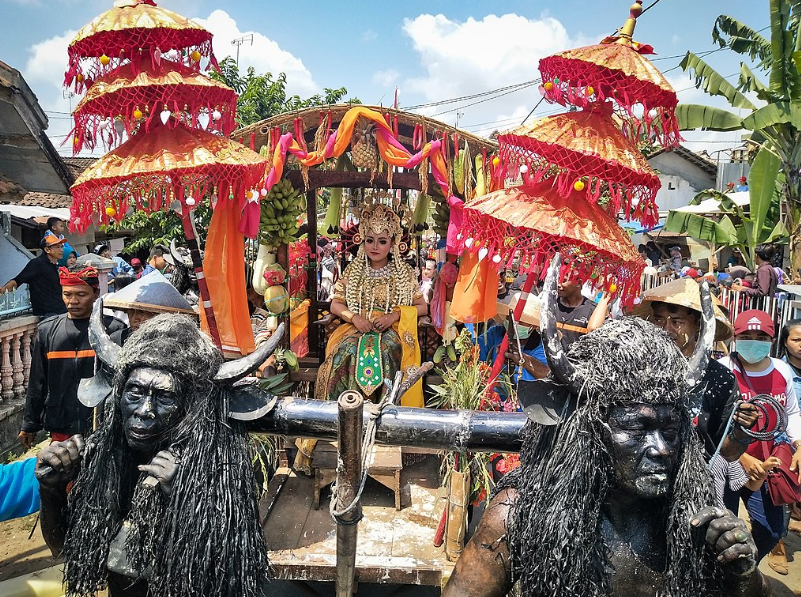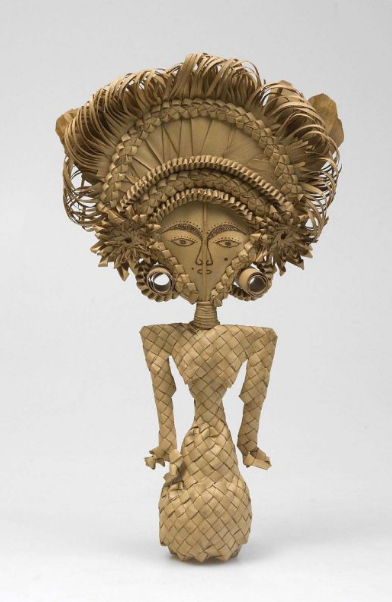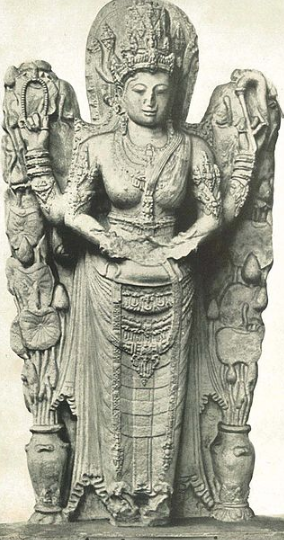Dewi Sri or Shridevi (Javanese: ꦢꦺꦮꦶꦱꦿꦶ), Dewi Sri) (Sundanese: Nyai Pohaci Sanghyang Asri) is the Javanese, Sundanese, and Balinese Hindu Goddess of rice and fertility, still widely worshiped on the islands of Java, Bali and Lombok, Indonesia. The cult of the rice goddess has its origin in the prehistoric domestication, development and propagation of rice cultivation in Asia, possibly brought by Austroasiatic or Austronesian population that finally migrated and settled in the archipelago. Similar but slightly different rice spirits mythologies are widespread among Indonesian ethnicities and also neighboring countries. The mythology of Dewi Sri is native to Java and Sunda and Hinduism in the archipelago since early as the first century. She was equated with the Hindu goddess Shri Lakshmi, and often regarded as an incarnation or one of her manifestations. The goddess is also associated with wealth and prosperity.
- shridevi
- fertility
- dewi
1. Attributes and Legends
Dewi Sri is believed to have dominion over rice, the staple food of Indonesians; hence life and wealth or prosperity; most especially rice surpluses for the wealth of kingdoms in Java such as Sunda, Majapahit and Mataram; and their inverse: poverty, famine, hunger, disease (to a certain extent). She is often associated with the rice paddy snake (ular sawah).
1.1. Mythology
Most of the stories regarding Dewi Sri are associated with the mythical origin of the rice plant, the staple food of the region. Examples of this can be found in the "Wawacan Sulanjana":[1] [2]
Once upon a time in heaven, Batara Guru (who in ancient Javanese Hinduism was associated with Shiva), the highest god commanded all the gods and goddesses to contribute their power in order to build a new palace. Anybody who disobeyed this commandment would be considered lazy and would lose their arms and legs. Upon hearing the Batara Guru's commandment, one of the gods, Antaboga (Ananta Boga), a Nāga god, became very anxious. He didn't have arms or legs and he wasn't sure how he could possibly do the job. Anta was shaped like a serpent and he could not work. He sought advice from Batara Narada, the younger brother of Batara Guru. But unfortunately, Narada was also confused by Anta's bad luck. Anta became very upset and cried.
As he was crying, three teardrops fell to the ground. Miraculously, after touching the ground the teardrops became three beautiful shining eggs that looked like jewels or pearls. Batara Narada advised him to offer these "jewels" to the Batara Guru, hoping that the gift would appease him and he would give a fair judgment, taking into account Anta's disability.
With the three eggs in his mouth, Anta went to the Batara Guru's palace. On the way there he was approached by an eagle who asked him a question. Anta kept silent and could not answer, as he was holding the eggs in his mouth. Because of his perceived unwillingness to answer, the bird thought Anta was being arrogant and it became furious, and began to attack Anta. As the result, one egg fell to earth and shattered. Anta quickly tried to hide in the bushes, but the bird was waiting for him. The second attack left Anta with only one egg to offer to the Batara Guru. The two eggs that had fallen to the earth became the twin boars Kalabuat and Budug Basu.[3] Later, Kalabuat and Budug Basu were adopted by Sapi Gumarang cow.


At last, he arrived at the palace and offered his teardrop in the shape of a shiny egg to the Batara Guru. The offer was graciously accepted, and the Batara Guru asked him to nest the egg until it hatched. Miraculously, the egg hatched into a very beautiful baby girl. He gave the baby girl to the Batara Guru and his wife.
Nyai Pohaci (sometimes spelled "Pwah Aci") Sanghyang Asri was her name, and she grew up into a beautiful princess. Every god who saw her became attracted to her, even her foster father, Batara Guru started to feel attracted to her. Seeing the Batara Guru's desire for his foster daughter, the gods grew worried. They feared that this scandal might destroy the harmony in heaven, so finally, they conspired to separate Nyi Pohaci and the Batara Guru.
To keep the peace in the heavens and to protect Nyi Pohaci's chastity, all the gods planned for her to die. She was poisoned, and her body was buried somewhere on earth in a far and hidden place. However, because of Sri Pohaci's innocence and divinity, her grave showed a miraculous sign; for at the time of her burial, some plants grew from the ground that would forever benefit mankind. From her head grew coconut; from her nose, lips, and ears grew various spices and vegetables, from her hair grew grass and various flowering plants, from her breasts grew various fruit plants, from her arms and hands grew teak and various wood trees, from her genitals grew Kawung (Aren or Enau: sugar palm), from her thighs grew various types of bamboo, from her legs grew various tuber plants, and finally from her belly button grew a very useful plant that is called padi (rice). In some versions, white rice grew from her right eye, while red rice grew from her left eye. All of the useful plants, essential for human needs and well-being, are thought to come from the remnant of Dewi Sri's body. From that time on, the people of the Island of Java venerated and revered her as the benevolent "Goddess of Rice" and fertility. In the ancient Sunda Kingdom, she was considered the highest goddess and the most important deity for agricultural society.
Most Dewi Sri myths involve Dewi Sri (also known as Dewi Asri, Nyi Pohaci, among others) and her brother Sedana (also known as Sedhana, Sadhana, Sadono, and others), set either in the kingdom of Medang Kamulan (corresponding to the historical Medang Kingdom) or in Heaven (involving gods such as Batara Guru) or both. In all versions where Sedana appears with Dewi Sri, they end up separated from one another, through either death, wandering, or a refusal to be married. Some versions make a correlation between Sri and the large Rice Paddy Snake (ular sawah) and Sadhana with the paddy swallow (sriti). The nāga or snake, particularly the king cobra is a common fertility symbol throughout Asia, in contrast to being considered representative of temptation, sin or wickedness as in Judeo-Christian belief.
1.2. Depiction


Dewi Sri is always depicted as a youthful, beautiful, slim yet curvaceous woman, with stylised facial features idiosyncratic to the respective locale, essentially a woman at the height of her femininity and fertility. In Javanese iconography, Dewi Sri is usually depicted wearing green, white or golden yellow clothes with regal jewelry attire, similar to Hindu goddess Laxmi, and holding a rice plant with full rice grains in one of her hands as her attribute (lakçana). High Javanese culture reflecting the wayang aesthetic dictates she be depicted with a white face, thin-downward cast eyes and a serene expression. There is much cross-pollination between the qualities, aesthetics and so forth between the deity Dewi Sri and the wayang character Sinta in the Javanese version of the Ramayana and the same for Rama with Sedhana. The loro blonyo (two "pedestals" or foundations) statue also have some overlap with Dewi Sri and Sedhana. Balinese people have certain rituals to rever Dewi Sri by making an effigy as her representation from janur (young coconut leaf), lontar leaf, or from cakes made of rice flour.
1.3. Ritual and Custom
Javanese traditional
procession bringing Dewi Sri image made from rice. By Arfani M - Own work, CC BY-SA 4.0, https://commons.wikimedia.org/w/index.php?curid=88154441
Dewi Sri remains highly revered especially by the Javanese, Balinese, and Sundanese of Indonesia though there are many regional analogues or variations of her legend throughout Indonesia. Despite most Indonesians being observant Sunni Muslims or Balinese Hindus the indigenous underlying animist-era beliefs, notably of Sunda Wiwitan and Kejawen, remain very strong, are worshiped parallel to Islam, Buddhism, Hinduism and Christianity without conflict; and are cultivated by the Royal Courts, especially of Cirebon, Ubud, Surakarta and Yogyakarta, which are also popular local and international tourist attractions. The Javanese harvest ceremony is called Sekaten or Grebeg Mulud which also corresponds to Maulid Nabi; the birth of prophet Muhammad.
Traditional Javanese people, especially those who are observant Kejawen, in particular have a small shrine called Pasrean (the place of Sri) in their house dedicated to Dewi Sri, decorated with her bust, idol or other likeness of her alone; or with Sedana and possibly with a ceremonial or functional ani-ani or ketam: a small palm harvesting knife, or arit: the small, sickle-shaped rice-harvesting knife. This shrine is commonly decorated with intricate carvings of snakes (occasionally snake-dragons: naga). Worshipers make token food offerings and prayers to Dewi Sri so she may grant health and prosperity to the family. The traditional male-female couple sculpture of Loro Blonyo is considered as the personification of Sri and Sedana or Kamarati and Kamajaya, the symbol of domestic happiness and family harmony.

A small shrine for Dewi Sri in the rice field, Karangtengah. By Tropenmuseum, part of the National Museum of World Cultures, CC BY-SA 3.0, https://commons.wikimedia.org/w/index.php?curid=8614343


Among the rural Javanese, there is the folk-tradition if a snake having entered a house it will not be chased away. Instead, the people in the house will give it offerings, as the snake is a good omen of a successful harvest. Additionally, a ceremonial or auspicious keris will be employed by a folk-healer, sooth-sayer, paranormal or shaman in a winding, circum-ambulatory ceremony to bless and protect the villagers, the village, their shrines and the seeds of rice to be planted.
The Javanese and Sundanese has a traditional ceremony called mapag Sri prior to rice harvest. Mapag Sri literary means "to pick up Sri", or to be precise "to call or invite Sri." The ceremony means to invoke the spirit of Sri to come to their village and also as a thanksgiving for a coming successful harvest.
The Sundanese people, especially those who are observant Sunda Wiwitan, have their own unique festival dedicated to her, such as the Seren Taun annual rice harvest festival, a tradition dated back to the ancient Kingdom of Sunda era. During the blessing of rice seeds ceremony before planting the seeds or during the harvest ceremony, Sundanese and also Baduy people, sing certain song such as Pangemat and Angin-angin. These songs were meant to call and invite the goddess to come down to earth and bless the rice seeds, bless the farmers, and ngaruwat or tolak bala; to ward off bad luck and to prevent all misfortune befell upon the people.[4]
The Balinese provide special shrines in the rice fields dedicated to Dewi Sri. The effigy of the rice goddess is often made from carefully weaved janur (young coconut leaf), lontar or pandan leaf, or colored sticky rice and is called "Cili". In current Balinese Hindu belief, Dewi Sri corresponds to an amalgamation of the Hindu goddesses Lakshmi, Devi, and Shri. She also associated with rice, fertility, successful harvest, and family prosperity and harmony.
Similar rice goddesses also can be found in other Asian countries such as Mae Po Sop; Siamese rice goddess in Thailand, and Khmer Po Ino Nogar; rice goddess of Cambodia.
2. Gallery
-

Stone figure of the rice goddess Dewi Sri with Vitarka Mudra. By Garten-Steinkunst - Own work, CC BY-SA 3.0, https://commons.wikimedia.org/w/index.php?curid=34225719
-
Dewi Sri in wayang puppet theatre. By Tropenmuseum, part of the National Museum of World Cultures, CC BY-SA 3.0, https://commons.wikimedia.org/w/index.php?curid=11028706
-

Cili, a Balinese Dewi Sri effigy from lontar palm leaf. By Tropenmuseum, part of the National Museum of World Cultures, CC BY-SA 3.0, https://commons.wikimedia.org/w/index.php?curid=11031214
References
- "Early Mythology - Dewi Sri". Sunda.org. http://www.sunda.org/sundanese/myths.htm.
- "(Indonesian) Mitos Nyi Pohaci/Sanghyang Asri/Dewi Sri". My.opera.com. 2008-03-01. http://my.opera.com/mrtaufik/blog/2008/03/01/mitos-nyi-pohaci-sanghyang-asri-dewi-sri.
- Edi Suhardi Ekajati; Undang A. Darsa; Oman Fathurahman (1999). Jawa Barat, koleksi lima lembaga. Yayasan Obor Indonesia, Ecole française d'Extrême-Orient. ISBN 9789794613313. https://books.google.com/books?id=RheSrkiK2zYC&q=Budug+basu&pg=PA225. Retrieved 29 March 2012.
- Galamedia (Indonesian), Angklung Gubrag, a Veneration for Dewi Sri. http://www.klik-galamedia.com/indexedisi.php?id=20100307&wartakode=20100307063352




